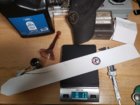memilanuk
Gold $$ Contributor
Barrel was hand tight. Shot 3 rounds, removed & used to bludgeon a cinderblock to pieces.
Then hand tightened back onto the action &shot another 3 rounds with virtualy no POI shift.
That's great... if the barrel is hand tight to begin with (as in that example).
If it starts out torqued, and becomes hand tight over time... I'd put my money on there being a POI shift.
If it goes from 'hand tight' to 'about ready to unscrew on its own'... again, I'd wager on a POI shift, with a fair bit of 'random walk' to it.














